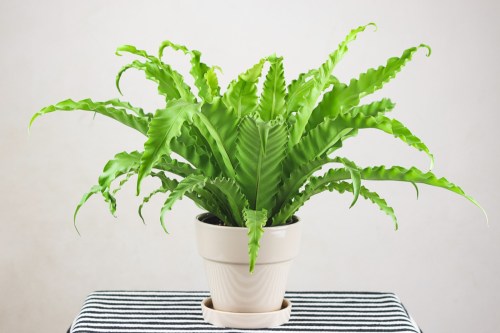
Ferns are beautiful. They can add a touch of elegance to the shade, whimsy to the shadow, and softness to the dark and damp. Can they do the same for the shady corners of your house, though, or are they limited to just your outdoor garden? This is what you need to know to keep your indoor ferns flourishing.
Basic fern care
Ferns, in general, are fairly low maintenance compared to other plants. They really only need a few things, most of which are pretty simple and make a lot of sense when you consider their natural habitat.
Ferns are typically forest plants. They grow in the underbrush, right underneath larger trees and between bushes. As such, they don’t need too much light and prefer shady environments. Forest floors are typically littered with decomposing leaves and logs, so it’s important to make sure your ferns have a lot of organic material in their soil.
Because it’s shady underneath trees, water doesn’t evaporate as quickly and is instead stored in the thick, rich soil and in the air. That’s why ferns prefer humid, moist environments. Keep your fern well-watered, sheltered, and in an area with moderate to high humidity.
Do indoor ferns need special attention?
Indoor ferns do need a little special consideration, but in most situations, you won’t need to make too many accommodations.
General care tips include:
- Planting them in a potting mix that’s rich in organic material (with the optional addition of homemade plant compost).
- Providing them with humidity. Keep your fern away from drafty places, like windows, which may dry the plant out. You can get a humidifier for your fern, but an easier solution may be to place them in or near your bathroom. Showers produce a lot of humidity!
- Giving them medium or dappled light.
- Keeping the soil moist and misting occasionally.
- Leaving them in moderate temperatures. Your fern’s preferred temperature depends on the variety, so make sure to read up on whichever variety you purchase.
- Supplementing your fern with a liquid fertilizer every few weeks.
How do you propagate indoor ferns?
While you can’t easily propagate ferns through cuttings, you can make more ferns through root division — the best time to do this is during the growing season. After watering your fern, gently remove it from its container and divide its roots into several clumps. You want to work with a mature, healthy fern, as you want each divided fern to have one or more growth points.
In nature, ferns also multiply through the spores on their underside, but conditions need to be fairly damp for propagation to be successful. You could also collect and sow the spores yourself, but this is a rather involved way to go about propagating ferns.
Which ferns grow well indoors?
Many types of ferns thrive indoors. Silver brake, bird’s nest, button fern, and Boston fern all do very well indoors and are low maintenance. Silver brake and bird’s nest can grow fairly tall, while button fern and Boston fern stay a bit smaller. Since they’re all relatively low maintenance, you can (usually) safely pick your fern based on appearance.
- Boston ferns are most likely what you’ve seen as indoor hanging ferns, especially in hotels or other businesses. They have tapering branches with small, ovular leaflets extending from either side.
- Bird’s nest ferns don’t look quite like classic ferns. They have long leaves rather than leaflets and sometimes have crimped or jagged edges.
- Button ferns have thin branches that curl over each other and feature very circular leaflets. They come in different shades of green and look similar to the string of pearls succulent.
- Silver brake ferns come in varieties that have leaflets and varieties that don’t. What they all do have, though, is a silvery white stripe down the center of each leaf or arm.
Can I move my ferns outside?
Yes, you absolutely can, provided you live somewhere with a climate they enjoy! Here are a few important things to keep in mind when moving your indoor ferns outdoors.
Firstly, what is the weather like and what will it be like for the next little while? Although it can be tempting to move a plant outside during the day when the weather is nice and bring it back inside at night when it cools off, this can actually be detrimental to your plant. Too much variance or too sudden of a change can stress your plant, which impacts its health. When you start moving your ferns outside, ensure the weather will be suitable for the next week to avoid unnecessary stress.
If your ferns are young, and you plan on moving them outdoors permanently, it’s important to harden them first. This means placing them outside for a few hours a day, gradually increasing the time they spend outside. Start them in a place that is protected from the elements and slowly move them to a more exposed location.
Now, this may sound counterintuitive. We just talked about sudden changes being stressful for plants, after all. Young plants, however, are more adaptable to stress, and this small amount of stress when they’re young helps them become tougher and more resistant to environmental stressors when they’re planted in your garden.
No matter if you’re looking for a Boston fern to leave indoors forever or a silver brake to move outside eventually, you’re now prepared to help your fern survive and thrive!
Editors' Recommendations
- How to care for philodendrons, a decorative indoor plant
- Jade plant care: A complete grower’s guide
- Elephant ear plant care guide: What you need to know
- How are Italian parsley and curly parsley different? Here’s what we know
- Can you grow plants in water beads? Here’s what you need to know